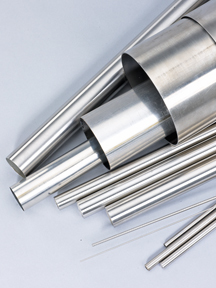
Stainless steel is the generic name for the widely popular family of corrosion-resistant metal alloys. There are several different types of stainless steel, but they have properties in common. When it comes to austenitic vs. martensitic, for example, the one commonality that they all share is a 10.5% minimum chromium content. Once chromium is alloyed to steel it forms a protective film on the steel surface, preventing any contact with oxygen. Depending on the material needs, other elements such as nickel, molybdenum, or titanium can be added to improve corrosion resistance and to provide additional necessary properties that can enhance the performance of the metal.
Stainless Steel Types
There are several families of stainless steel. The three most popular are austenitic, ferritic, and martensitic, the names of which are derived from their respective steel characteristics. Within each family, there are numerous numerical grades or compositions of stainless steel, i.e., the 300 series or 400 series that refer to its alloy composition and the mechanical properties for various environments and applications.
Austenitic Stainless Steels
Austenitic stainless steels account for more than 70% of stainless steel production, with type 304 being the most common grade of stainless steel used. The basic composition of austenitic steels is 18% chromium and 8% nickel. However, type 316 contains 16% to 18% chromium and 11% to 14% nickel which make it exceptional for applications in corrosive environments. The nickel content is higher in austenitic than ferritic and martensitic stainless steels. The steel is non-magnetic, is hardened significantly by cold-working and is known for its high corrosion resistance, formability, weldability, and other fine mechanical properties. The austenitic grades are found in the 200 series and 300 series, and are widely used for cookware, food and beverage equipment, processing equipment, and also in the automotive industry, chemical processing,, and the pulp and paper industry.
Ferritic Stainless Steels
Classified in the 400 series grade, ferritic stainless steels account for approximately 20% of the stainless steel market. They consist of a lower carbon with varying chromium content between 10.5% and 18% and, like martensitic stainless steel, it contains no nickel. Ferritic steels are magnetic, have good ductility, and formability, and, like austenitic stainless steels, are not heat-treatable. They are highly resistant to stress corrosion cracking, offer very good tensile-property stability and have better thermal fatigue resistance, lower thermal expansion, and higher thermal conductivity than austenitic grades. The most common ferritic grade is type 430, known for its high corrosion resistance to nitric acid, sulfur gases, and many organic and food acids. Other grades are type 405, 409, 434, 436, 442, and 446. In general, ferritic steels are used in elevated-temperature applications such as exhaust systems for vehicles. Other applications for ferritic stainless steel include petrochemical components, automotive trim, heat exchangers, furnaces, appliances, and food equipment to name a few.
Martensitic Stainless Steel
Martensitic stainless steels contain 12% to 18% chromium with a relatively high carbon content compared to other stainless steels. These grades of stainless steel are straight chromium with no nickel. They are characterized by high strength, have magnetic properties, acceptable corrosion resistance, and can be hardened through heat treatment. Martensitics are best suited for applications that require hardness, strength, and wear resistance. This grade is in the 400 series, including types 410, 410S, 4141, 416, 420, 431, and 440. General-purpose martensitic stainless steel is listed as grade 410. Grade 420 is used for surgical cutting tools. Martensitic stainless steels are used in cutlery, surgical and dental instruments, springs, scissors, industrial blades, aerospace components, and other general engineering components.



